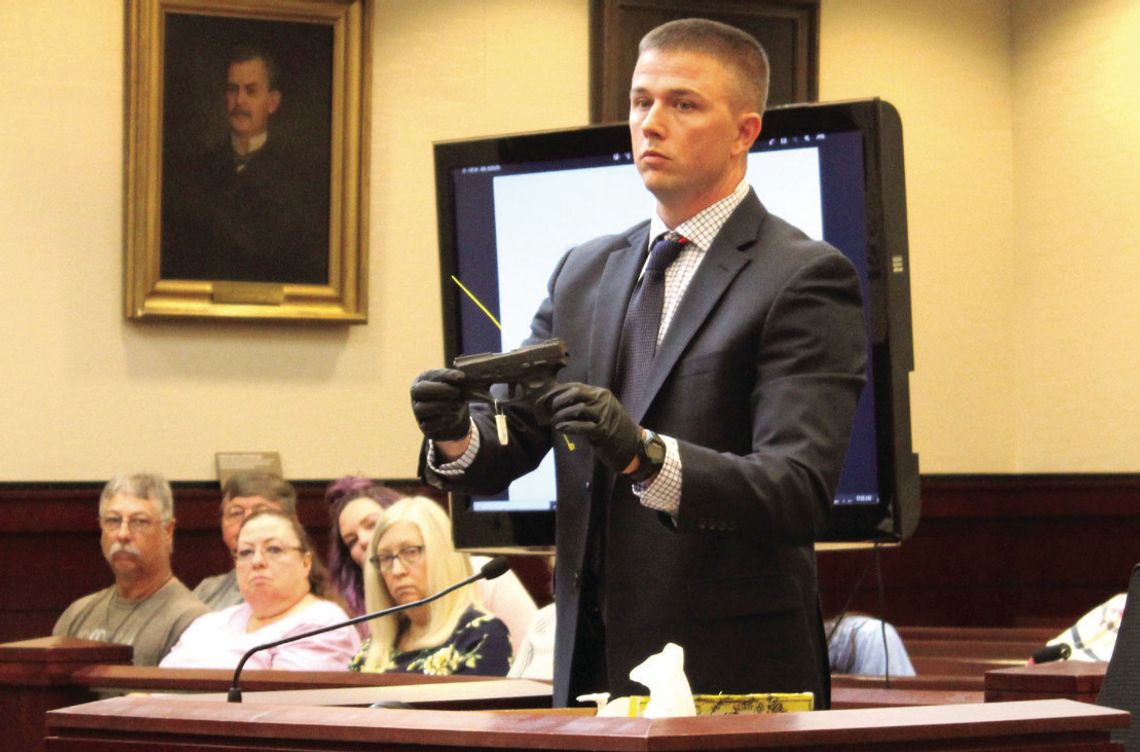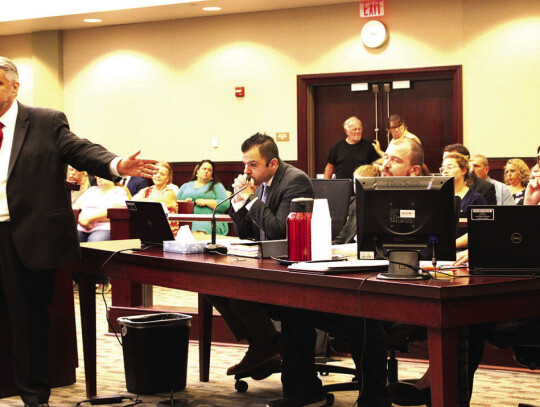After three days of testimony and three hours of deliberation, a jury found Jonathan Armstrong Watkins, 36, of Natural Bridge, guilty of murder in the second degree and use of a firearm in the commission of murder in the death of Katrina Leeann Dudley on Dec. 10, 2021. The verdict came Friday afternoon, concluding a week-long trial in Rockbridge County Circuit Court. Watkins had been charged with murder in the first degree.
Rockbridge County Commonwealth’s Attorney Jared Moon said that he felt “very good” about the verdict and that “the family does as well.”
“We are very pleased that Mr. Watkins will be held responsible for his actions, and we are looking forward to his sentencing hearing and to see exactly how much justice will be exacted in this case,” he said.
“Emotions were very high, especially for the immediate family,” he added. “A lot of answered prayers happened today.”
Prior to hearing any details about the events of Dec. 10, 2021, the jury heard testimony from Felicia Ann Dudley, Katrina’s mother. Dudley testified that her daughter, who had worked in nursing care in several nursing home facilities, was someone who “always loved helping people and animals.”
“Every time she lost a patient, even though it was hard on her, she wanted to go back and help people,” she said.
She testified that her daughter hadn’t been working for “a while,” but that in talking to her on Dec. 9, she learned that Katrina had just gotten a job at Wal-Mart. She also noted that Watkins, with whom she’d been in a relationship for a year-and-a-half, was “mad because [she was] going back to work.”
She described her daughter as a “very outdoorsy girl” who “enjoyed going up in the woods and going hunting and fishing.” Dudley testified that Katrina had recently purchased a gun prior to her death, but couldn’t remember what type of g un i t w as. S he a lso t estified that Katrina carried a knife in her back pocket “all the time.”
At the time of her death, Katrina was living with Watkins in a trailer owned by her mother at 59 Hummingbird Lane, just off of Plank Road. The couple had been living in the trailer since October, but had no phone, internet or television, as Felicia had shut all of them off after the previous residents, her mother and stepfather, had passed away. Dudley also testified that Katrina didn’t have a working cell phone at the time and when she did talk to her daughter, Dudley said she would call from a landline, usually at either Watkins’ mother’s house or his grandfather’s house. Katrina did own a car, a Mercury Milan, but Dudley testified that Watkins had been using it more without her, noting that she saw him driving the car in Lexington without Katrina. Katrina told her mother that Watkins’ vehicle wasn’t working and he needed to use her car.
At The Scene
Following Dudley’s testimony, the jury heard from numerous officers who responded to the trailer on 59 Hummingbird Lane on the morning of Dec. 10, 2021. Donna Moore, Watkins’ mother, called 911 at 12:31 p.m., informing the dispatcher that Watkins had arrived at her house, distraught, covered in blood and saying Katrina had been shot. Trooper Zachary Davis with the Virginia State Police was patrolling in Rockbridge County that morning and heard the call over the radio at 12:35. After asking if county officers needed assistance in responding, he was told to proceed to Hummingbird Lane. Davis was the first officer to arrive at the scene, reaching the trailer at 12:42. He entered the trailer to clear it, noting that the front door was “cracked open.” While clearing the trailer, he came across a body, later identified as Katrina Dudley. He checked for a pulse twice, once during his initial sweep of the residence and again before leaving and was unable to detect a pulse either time.
Deputies from the Rockbridge County Sheriff’s Office began to arrive on the scene soon after, and Emergency Medical Services responded as well, reaching the scene at 12:48. Lisa Davis, a medic who was working for the Rockbridge County EMS in December of 2021, was stationed with the Glasgow Rescue Squad on the morning of December 10. She responded to the scene and, after it was secure, accompanied Rockbridge County Investigator Ryan McCullough into the trailer to examine the body and confirm that Dudley was deceased. At 12:59, Davis reached Dudley’s body, attaching electrodes for a heart monitor to her. No activity was detected, and Davis determined that Dudley had been deceased for at least 10 minutes at that point.
While deputies were securing the scene, Watkins and his mother arrived on the scene but were prevented from approaching the trailer by Deputy Daniel Trout. Trout spoke to Watkins, who was seated in the passenger seat of his mother’s car and noticed a “red substance consistent with what appeared to be blood” on Watkins’ hands. Trout recorded part of the conversation he had with Watkins, and when asked what happened, Watkins said, “She got to shoving on me and anyways she grabbed the gun and … I went to take it away from her, [and] the son of a bitch went off.”
Watkins was then transported to the sheriff’s office, where his clothing was collected. Red stains were noted on the left knee of his pants and on his left shoe. While at the station, samples of the red stains on his hands were taken.
Physical Evidence
After the scene was secure, investigators set about collecting evidence and documenting the scene. Lieutenant Josh Berry with the Rockbridge County Sheriff’s Office was tasked with collecting physical evidence at the trailer and testified about the state of the trailer when investigators arrived, all of which was documented with photographs.
There were several signs of a struggle in the trailer. A bottle of baby powder was found in a bedroom at the end of a hall to the right of the trailer, away from the body, with baby powder being found in different places throughout the trailer, including on the bathroom door and on a recliner in the living room where Dudley and Watkins were primarily living, sleeping on a mattress on the floor. The door to the bathroom, which was located down the hall from the bedroom heading back toward the living room, had been broken, with both knobs being found on the floor inside the bathroom and the latch hanging loose. In the kitchen, on the other side of the living room, a chair was found turned over, with one leg and part of the back broken off.
Dudley’s body was in the living room, sitting up against the mattress. A pool of blood was found to the left of the body, with what appeared to be bloody footprints around it. A flip-flop with what appeared to be blood on the sole was lying nearby. Several drops of blood, which Berry described as “cast off” were found on items nearby, including a plastic water jug and a guitar case. Blood transfer was found on other items, including a laundry basket lying near the kitchen. Blood drops were found on the front door and on the floor by the door. Samples from the door, the nearby floor, and the pool near the body were collected and sent to the forensic lab in Roanoke for analysis.
Less than 10 feet away from the body, on the right side of the living room, a 9mm shell casing was found and collected, as was a Taurus 9mm handgun. The gun was eight feet, three inches from the body and the casing was seven feet, eight inches from the body. A seven round magazine was found inside the gun with seven rounds still inside. Berry testified that the firearm could hold up to eight rounds – seven in the magazine and one in the chamber. The safety on the gun was off. A copper bullet jacket was found near the wall behind the mattress. An indentation on the wall above where the jacket was found was noted, as was a similar defect on a blade of the ceiling fan above the mattress. The gun, casing and jacket were also sent to Roanoke for analysis.
Several other guns were found throughout the trailer. Near the mattress, a .380 caliber hand gun was found with two rounds inside. A .25 caliber hand gun and a Martin .22 caliber rifle were collected from the bathroom closet, a loaded 357 magnum revolver was found in the cabinet the couple used as a pantry and a .22 caliber revolver with the cylinder removed was found in a backpack underneath the TV beside the body. Several rounds of ammunition were also collected, including another magazine for the 9mm handgun which contained six bullets. A dozen 9mm rounds, consistent with the rounds found in the gun and the casing that was collected, were found in a bowl on the kitchen table and a 9mm hollow point round was found in the bathroom closet. A single round for the 357 magnum was found on the kitchen table and a box of .22 caliber ammunition was collected from the bathroom closet. A plastic bag containing another 18 rounds of 9mm ammunition was found inside a backpack belonging to Watkins inside Dudley’s car. The car, at the time of the search on the night of Dec. 10, was still at Moore’s house on Back Run Road.
In addition to the guns and ammunition, a folding knife was found in Dudley’s back pocket and collected into evidence. Several other knives were documented throughout the trailer, but none were collected as evidence.
The Interview
While evidence was being collected, Watkins was being interviewed by Investigator Chris Young. Watkins was brought into the interview room at the sheriff’s office just before 1:40 pm on the afternoon of Dec. 10 and, with the exception of a few breaks for various reasons, was interviewed until 11 p.m. that night when he was formally arrested and charged with murder.
During the interview, Watkins stated that he and Dudley had a fight the night before about him leaving. He said that she had locked herself in the bathroom and had threatened to hurt herself, but that he managed to talk her out and calm her down. The fight had continued the next morning, with Watkins making the decision to leave, that he and Dudley needed to take a break. Dudley, he said, then locked herself in the bathroom again and was threatening to hurt herself, holding a knife to her throat. He said he took the door knobs off to get her out and then started packing a bag. He’d grabbed the 9mm gun to take it with him because he didn’t want to leave it there for her to potentially hurt herself. He said that Dudley grabbed the gun from him and he tried to take it back and in the ensuing struggle, the gun went off. Watkins then said he picked Dudley up and noticed that she was still breathing and left to get help, driving to his mother’s house on Back Run Road to get her to call 911.
Throughout the more than nine-hour interview, a number of details about the struggle changed, with Watkins at one point describing it as a “push-pull thing,” then saying that Dudley had shoved him. He said that she’d grabbed the gun, then claimed that it was in his hands and she’d grabbed for it. At one point in the interview, he said that Dudley hadn’t grabbed the gun, but that her hand had hit it and that’s what caused it to go off.
When initially asked how they were standing in relation to each other, Watkins initially responded that he didn’t know, then said they were “face to face.” He maintained throughout the interview after that that he and Dudley were facing each other when the gun went off. He also denied knowing how the gun had gone off, claiming that he “would never pull the trigger on that girl.”
“What matters is that the gun was in your hands,” Young told him. “And [in] hers, but in your hands and it went off and shot her. You shot her. You can say you didn’t mean to shoot her.” Watkins did not respond to that.
Watkins said he was taking the 9mm with him when he left so that Dudley couldn’t use it to hurt herself. When asked about other firearms in the house, Watkins mentioned the .380 caliber handgun and the rifle, but denied knowledge of any other guns in the house. He also didn’t mention trying to take any of the knives found at the scene.
Later in the interview, around 10 pm, after being confronted with the fact that there was a bullet wound in the top of Dudley’s head and asked how she was shot in the top of the head, Watkins denied shooting her in the top of the head, saying that it wasn’t possible since she was standing on the mattress when the gun went off. The entrance wound behind Dudley’s right ear would be discovered during the autopsy the following morning.
“I never would have planted a bullet in the top of that girl’s head,” Watkins said. “I don’t care what she’d done.”
When asked what route he took to get to his mother’s house, Watkins initially said he didn’t remember, but later walked Young through a 13mile route along back roads between Hummingbird Lane and Back Run Road. The route took him past several businesses, as well as the Natural Bridge Fire Department and Rescue Squad and an active forest ranger station, as well as a number of residences. When asked why he didn’t stop anywhere closer to Hummingbird Lane to get help, Watkins didn’t have an explanation, but he did say that he felt that the people living on Plank Road were “snooty” and didn’t like him so he didn’t stop at any of their houses. Young testified that he later drove the route Watkins described on two separate occasions and that it had taken him around 23 minutes to complete it each time.
The next day, Dec. 11, Young interviewed Watkins again, this time following the autopsy which found the entrance wound. Watkins maintained that he and Dudley were facing each other and that the gun was in his right hand and she was reaching for it with her left, but couldn’t explain how Dudley had been shot on the right side of her head.
Forensic Evidence
Dr. Amy Thorpe, who conducted Dudley’s autopsy, testified that there were two injuries to Dudley’s head: One behind her right ear and one on the top left side of her head. The two wounds indicated the bullet had traveled on an upward trajectory, traveling from right to left. Thorpe also found stippling, or a pattern of burned gunshot residue, around the wound and charring on Dudley’s right ear, which indicated that the gun was in close proximity to her head when it was fired. Thorpe was informed of Watkins’ statements regarding how the gun was fired and concluded that “the range of fire and location of entrance do not correspond with any of the explanations provided.”
Thorpe requested that gunshot residue pattern tests be conducted by the forensics lab in Roanoke to more accurately determine how far from Dudley’s head the gun was when it was fired. Wendy Gibson, a firearm and tool mark analyst, conducted the tests, firing the Taurus 9mm gun at different distances from a skin stimulant and submitting the patterns for analysis. The gun was fired at .5 inches, 1.5 inches, three inches, six inches, nine inches and 15 inches away and it was determined based on that test that the gun was between 1.5 and three inches from Dudley’s head when it was fired, likely closer to 1.5 inches. Gibson also analyzed the 9mm casing and copper jacket found at the scene, determining through tool mark analysis that both came from the Taurus 9mm that was collected at the scene.
Kathleen Holtznagel, a DNA analyst with the Roanoke forensics lab, examined the blood samples collected from the trailer and from Watkins’ hands. DNA profiles were created from the samples from the trailer – from the front door, floor and the pool near the body – and all three were compared to samples from Watkins and Dudley at 24 specific markers. Watkins was eliminated as a contributor for all three but Dudley could not be. Holtznagel testified that the probability of the samples coming from someone other than Dudley was greater than 1 in 7.2 billion. The samples from Watkins’ hands were determined to be a mixture of his and a second contributor. Dudley could not be eliminated as the second contributor.
Holtznagel also tested the Taurus 9mm for DNA, swabbing it for potential touch DNA from skin cells. She swabbed several areas of the gun, including the textured parts of the handle, the slide and the trigger. After collecting the swab, she realized that blood was indicated that she had not been able to see, but couldn’t determine which part of the gun the blood came from. A DNA profile was developed from the swab and was determined to be a mixed sample from at least three contributors. Holtznagel was unable to generate any further analysis of the sample, so it was sent to the Department of Forensic Science’s main lab in Richmond for further analysis.
Lisa Schiermeier-Wood received the sample and ran the sample through an analysis program along with samples from Watkins and Dudley. Neither of them could be eliminated as contributors to the sample. Watkins, Schiermeier- Wood testified, was 4.1 quadrillion times more likely to be a contributor than an unrelated African-American person, 220 trillion times more likely than an unrelated Hispanic person and 83 trillion times more likely than an unrelated Caucasian person. She also testified that Dudley was 5.4 quadrillion times, 230 trillion times and 83 trillion times more likely to be a contributor than an unrelated person from those respective ethnicities.
A sentencing hearing for Watkins is scheduled for Nov. 28 in Rockbridge County Circuit Court. Moon told The News-Gazette that members of Dudley’s family will testify at the hearing. The sentence for a second-degree murder conviction is five to 40 years, with up to $100,000 in fines. Using a firearm in commission of a homicide carries a minimum sentence of three years.
Watkins was also charged with maliciously discharging a firearm in an occupied dwelling, but that charge was dropped prior to the start of the trial, and he pleaded guilty in circuit court on Monday to a charge of possession of a firearm by a nonviolent felon within 10 years of conviction. He will be sentenced on that charge in November as well.






